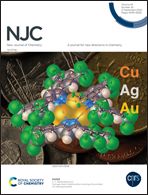A selective purine-based fluorescent chemosensor for the “naked-eye” detection of zinc ions (Zn2+): applications in live cell imaging and test strips†
Abstract
A new “turn-on” fluorescent probe (PTAHN) based on a biological purine derivative for detecting Zn2+ was designed, synthesized and characterized. The PTAHN exhibited remarkable selectivity and rapid response toward Zn2+, as well as obvious fluorescence enhancement upon combining with Zn2+ in a HEPES buffer system at pH 7.4. The limit of detection (LOD) for Zn2+ (61.6 nM) is much lower than the WHO standards (76.0 μM). Meanwhile, an obvious color change can be visually observed by the naked eye between PTAHN and PTAHN–Zn2+. What's more, the sensing mechanism of PTAHN toward Zn2+ was supported by the Job's plot, 1H NMR and density functional theory (DFT) studies. Interestingly, the novel probe is cell-permeable and can be successfully used for the detection of intracellular zinc ions in living HepG-2 cells.



 Please wait while we load your content...
Please wait while we load your content...